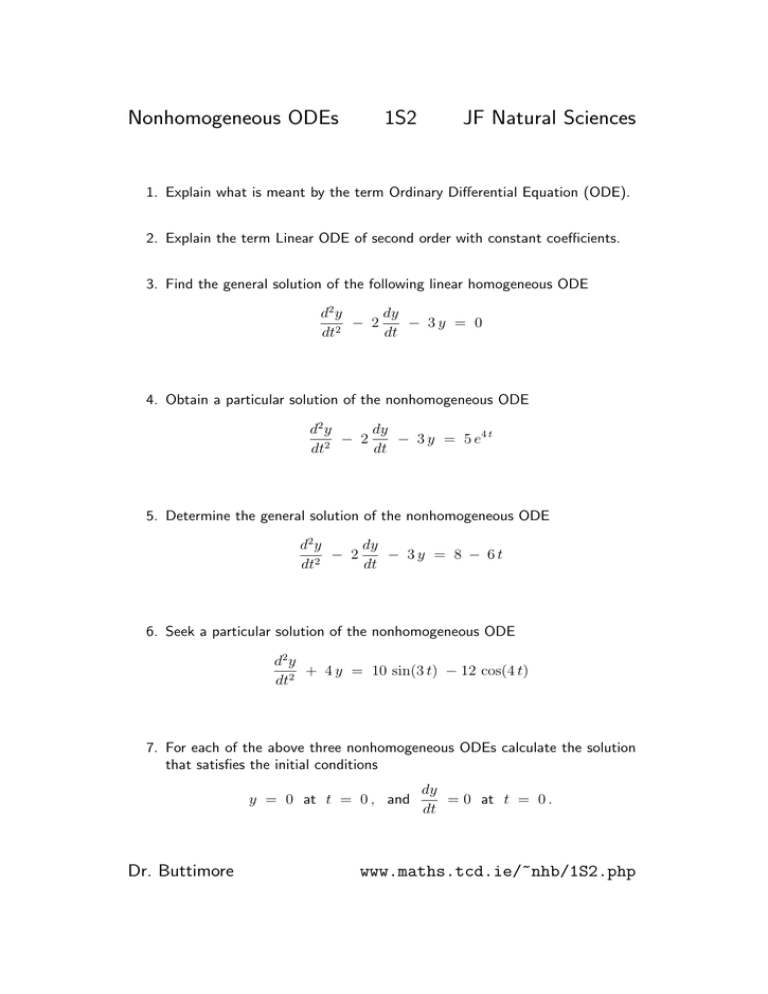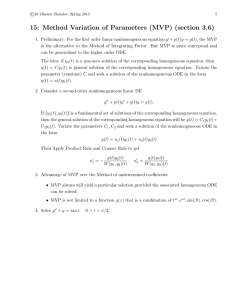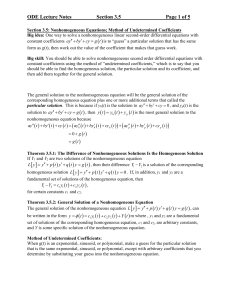Nonhomogeneous ODEs 1S2 JF Natural Sciences
advertisement

Nonhomogeneous ODEs 1S2 JF Natural Sciences 1. Explain what is meant by the term Ordinary Differential Equation (ODE). 2. Explain the term Linear ODE of second order with constant coefficients. 3. Find the general solution of the following linear homogeneous ODE d2 y dy − 2 − 3y = 0 2 dt dt 4. Obtain a particular solution of the nonhomogeneous ODE d2 y dy − 2 − 3 y = 5 e4 t dt2 dt 5. Determine the general solution of the nonhomogeneous ODE d2 y dy − 2 − 3y = 8 − 6t 2 dt dt 6. Seek a particular solution of the nonhomogeneous ODE d2 y + 4 y = 10 sin(3 t) − 12 cos(4 t) dt2 7. For each of the above three nonhomogeneous ODEs calculate the solution that satisfies the initial conditions y = 0 at t = 0 , and Dr. Buttimore dy = 0 at t = 0 . dt www.maths.tcd.ie/~nhb/1S2.php Background Explanations for Non Homogeneous ODEs • The general solution of the following linear homogeneous ode written with y 0 representing the first derivative and y 00 representing the second derivative, y 00 − 6 y 0 + 5 y = 0 , is found from trial solutions of the form y = e λ t leading, on substitution and division by the nonzero e λ t to the quadratic equation λ2 − 6λ + 5 = 0 with roots λ1 = 1 and λ2 = 5. It may be shown that the general solution y h of the homogeneous ode, and this may be checked by substitution, involves a linear combination of trial solutions, weighted with arbitrary constants c1 and c2 , y h = c1 e λ1 t + c2 e λ2 t = c1 e t + c2 e 5 t . • A particular solution of a nonhomogeneous ode with polynomial right side y 00 − 4 y 0 − 5 y = 10 t − 7 is found from trial solutions of polynomial form, often of a similar degree, yp = b t + c whose undetermined constant coefficients b and c may be found by noting y 0 = b and y 00 = 0 before substituting y, y 0 and y 00 in the ode leading to the identification 0 − 4 b − 5 ( b t + c ) = 10 t − 7 . For agreement at all values of t, the constant and t terms must match; so b = −2 and c = 3 and the particular solution to the ode is therefore y p = 3 − 2 t . • A particular solution of a nonhomogeneous ode with functions such as y 00 − 6 y 0 + 5 y = sin(2 t) + e 3 t is similarly obtained by finding the coefficients a, b, c when substituting a trial solution necessarily including sines and cosines with the same argument y p = a cos(2 t) + b sin(2 t) + c e 3 t . Dr. Buttimore 1S2 School of Mathematics






